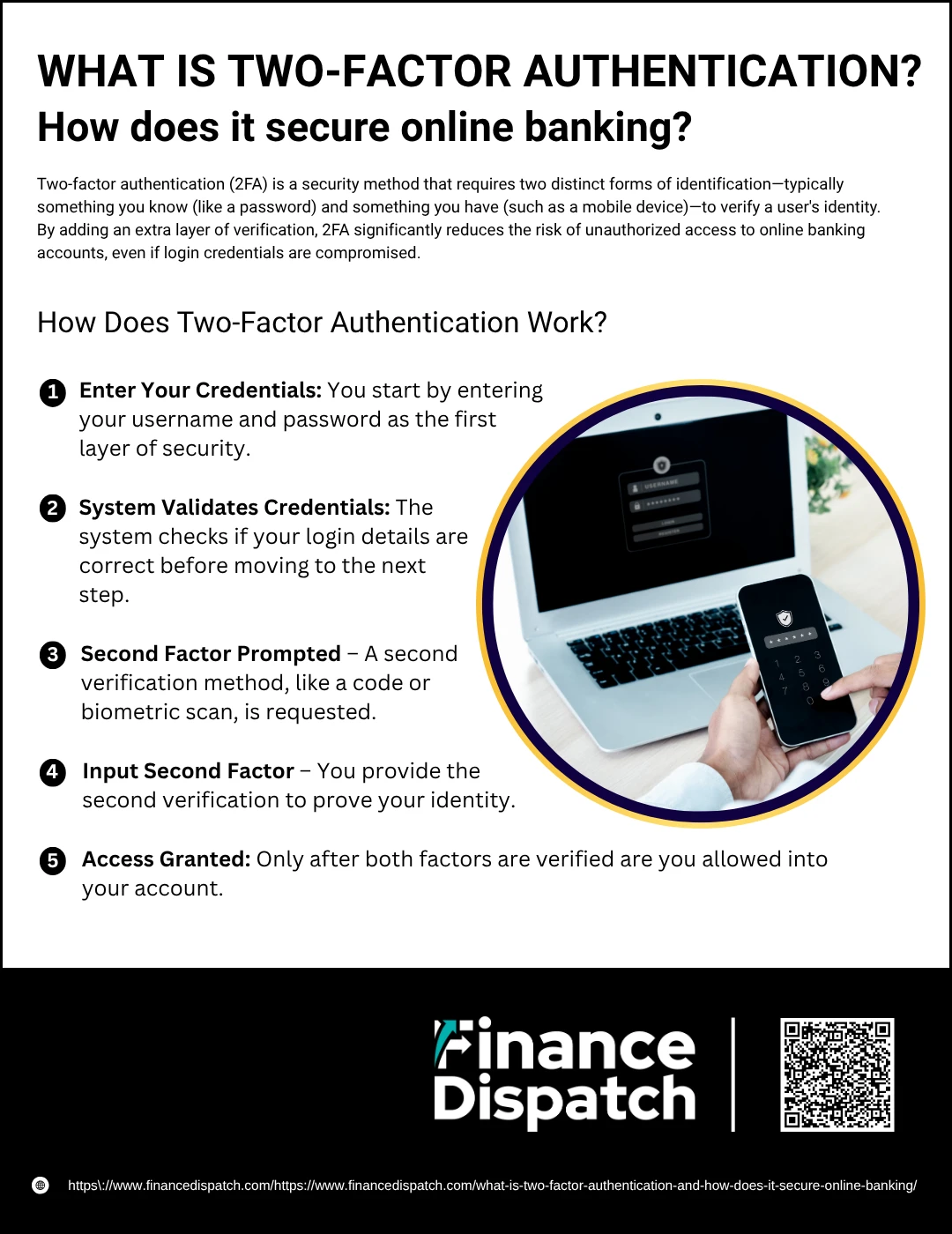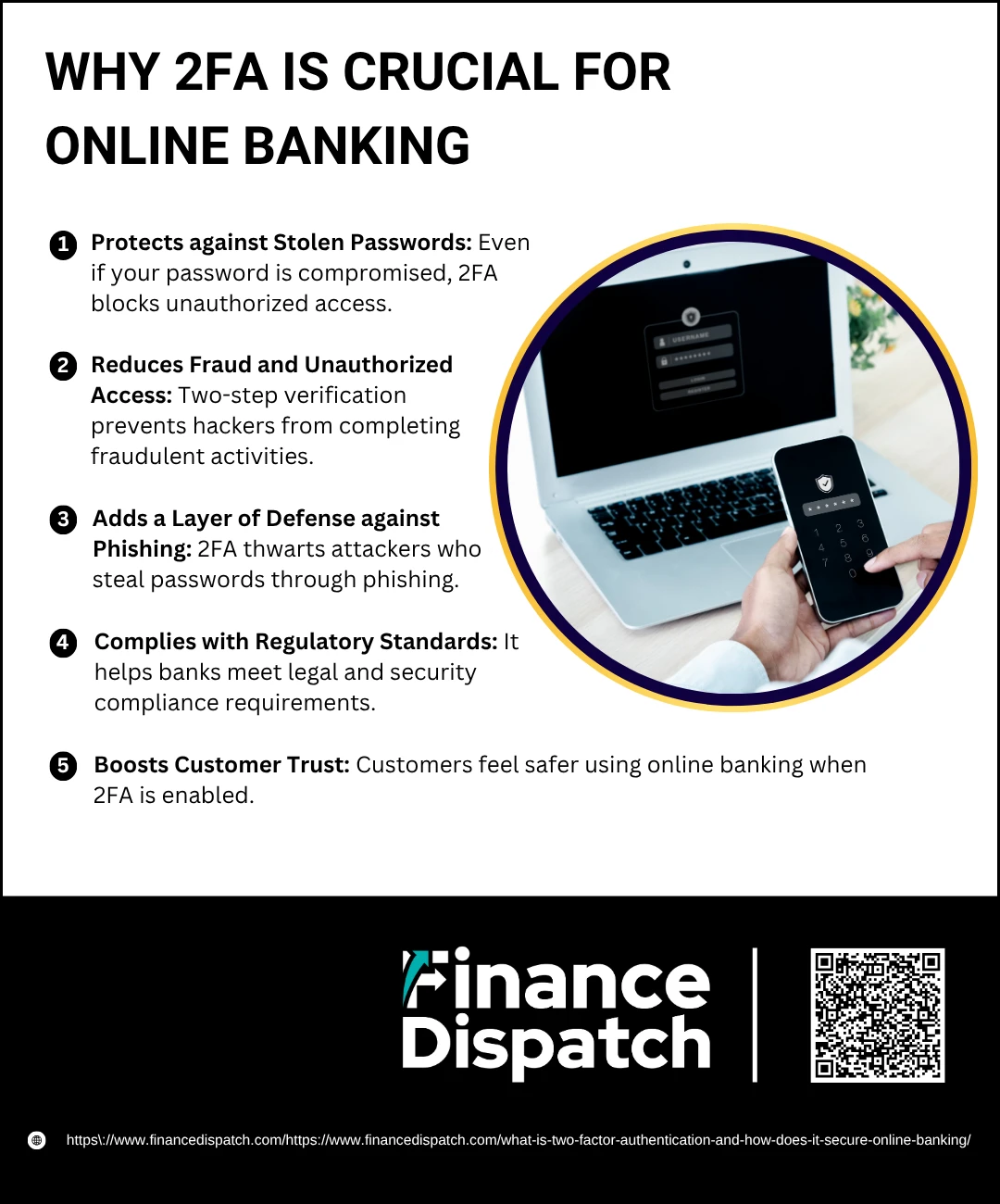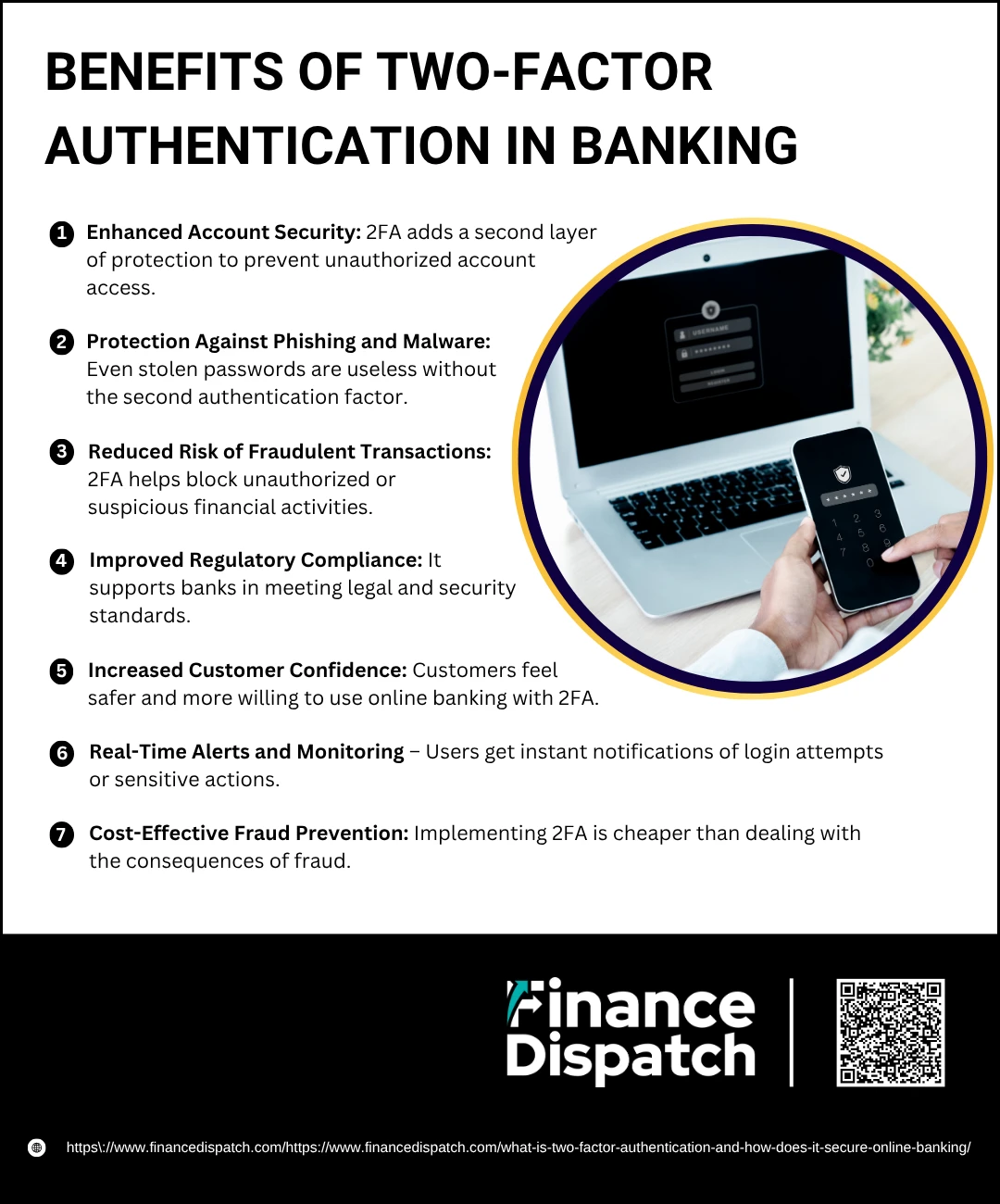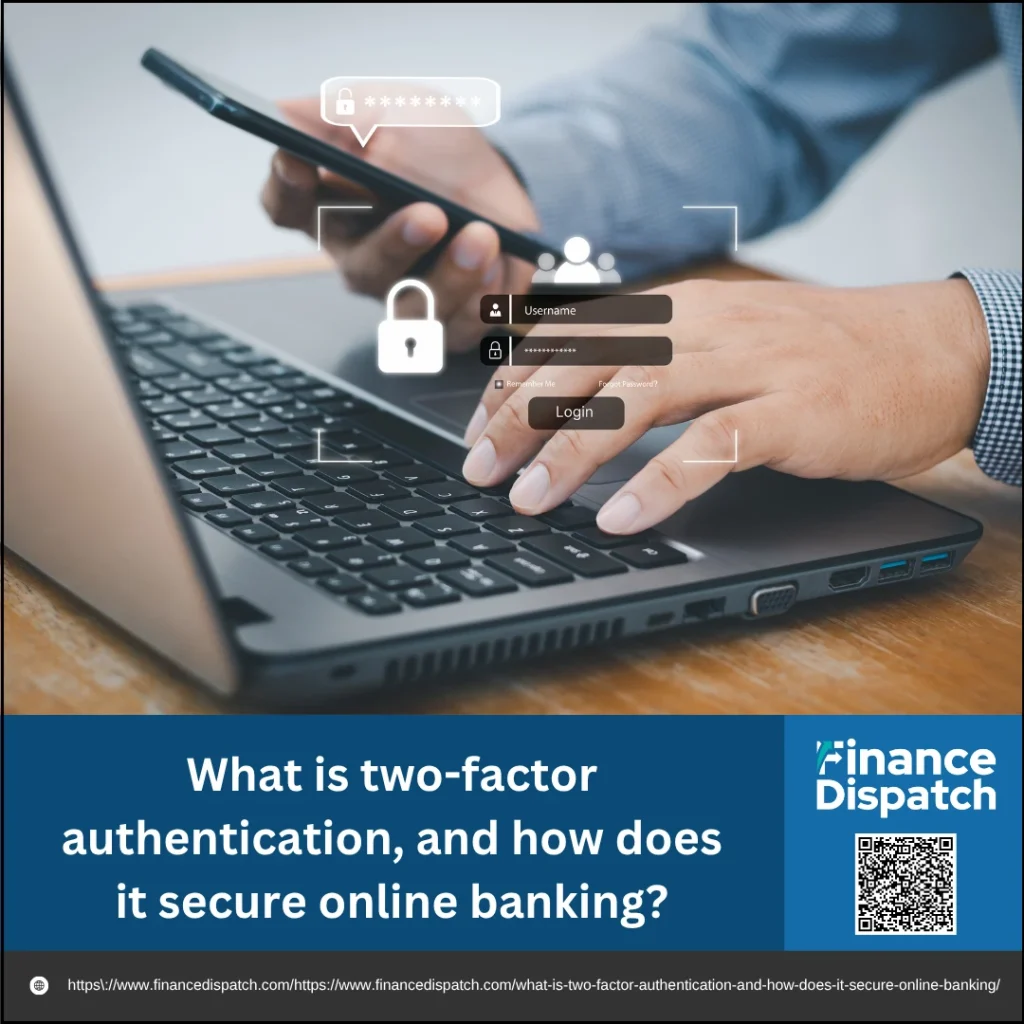In today’s digital world, protecting your financial information is more important than ever. With cyberattacks becoming more sophisticated, relying on just a password is no longer enough to secure your online banking activities. That’s where two-factor authentication (2FA) comes in. This powerful security method adds an extra layer of protection to your accounts by requiring not just something you know—like a password—but also something you have or are, such as a code on your phone or your fingerprint. In this article, we’ll explore what 2FA is, how it works, and why it plays a vital role in safeguarding your online banking experience.
What Is Two-Factor Authentication?
Two-factor authentication (2FA) is a security process that strengthens account protection by requiring two distinct forms of identification before granting access. Instead of relying solely on a password, 2FA combines something you know—like a password or PIN—with something you have, such as a smartphone or a hardware token, or something you are, like a fingerprint or facial recognition. This layered approach significantly reduces the risk of unauthorized access, even if your password is compromised. By requiring a second step, 2FA makes it much harder for cybercriminals to break into your accounts, providing a more secure way to access sensitive services like online banking.
 How Does Two-Factor Authentication Work?
How Does Two-Factor Authentication Work?
Two-factor authentication (2FA) is designed to enhance your account security by requiring a second form of verification in addition to your password. This method ensures that even if a hacker gets hold of your password, they still can’t access your account without the second authentication factor. The process is simple yet powerful, involving a sequence of steps that confirms your identity through a combination of what you know, what you have, or who you are.
Step-by-Step Breakdown of the 2FA Process
1. Enter Your Credentials
You begin the login process by entering your username and password, which serves as the first authentication factor—something you know. This is the traditional login step that most users are already familiar with.
2. System Validates Credentials
Once your credentials are submitted, the system verifies them against its database. If the password is correct, you move on to the second stage of authentication. If the password is incorrect, access is denied immediately.
3. Second Factor Prompted
After confirming your password, the system triggers a request for a second form of verification. This could be:
- A one-time password (OTP) sent to your registered mobile number via SMS
- A time-based code generated by an authenticator app
- A biometric scan such as fingerprint or facial recognition
- A push notification to your mobile device asking you to approve or deny the login attempt
4. Input Second Factor
You provide the second form of authentication. This could mean typing in the OTP you received, scanning your fingerprint, or tapping “Approve” on a push notification. This step proves you have something (like your phone) or are someone (like your biometric identity) that matches the account owner.
5. Access Granted
If both the password and the second factor are successfully verified, the system grants you access to your account. If either factor is missing or incorrect, the login attempt is blocked. This dual verification process drastically reduces the chances of unauthorized access.
Types of Two-Factor Authentication Methods
Two-factor authentication (2FA) can be implemented in various ways, depending on the platform, user preference, and security requirements. Each method involves a unique second factor that adds a strong layer of protection to your account. While some options focus on convenience, others prioritize security. Understanding the differences between these methods can help you choose the one that best fits your needs—especially for sensitive tasks like online banking.
| Authentication Method | Description | Advantages | Disadvantages |
| SMS-Based Code | Sends a one-time password (OTP) to your registered mobile number. | Easy to use, no app required | Vulnerable to SIM swapping and message interception |
| Authenticator App | Uses apps like Google Authenticator to generate time-based OTPs. | More secure than SMS, works offline | Requires initial setup and smartphone access |
| Biometric Verification | Uses fingerprint, face, or iris recognition to confirm identity. | Highly secure and fast | Needs compatible hardware and can raise privacy concerns |
| Push Notification | Sends an approval request to a secure app on your device. | Quick and convenient, reduces phishing risks | Can be mistakenly approved or ignored |
| Email-Based Code | Sends a verification code or link to your email address. | Simple to use, no app required | Insecure if email is compromised |
| Hardware Token | Uses a physical device (e.g., USB key, fob) to generate OTPs. | Extremely secure, hard to hack remotely | Costly, can be lost or forgotten |
 Why 2FA Is Crucial for Online Banking
Why 2FA Is Crucial for Online Banking
Online banking offers unmatched convenience, allowing you to transfer funds, pay bills, and check balances from your smartphone or computer. But with that convenience comes a greater risk of cyber threats such as phishing attacks, data breaches, and identity theft. Because financial accounts are a prime target for hackers, simply using a password is no longer enough. Two-factor authentication (2FA) is essential in reinforcing your bank account’s security. It works by requiring a second piece of verification—like a code sent to your phone or a fingerprint scan—before you can access your account. This double-check helps ensure that only you, and not a cybercriminal, can carry out banking transactions.
Key Reasons Why 2FA Matters in Online Banking
1. Protects against Stolen Passwords
Even the strongest passwords can be stolen through phishing emails, malware, or data leaks. With 2FA in place, a stolen password alone isn’t enough to access your online banking account. The attacker would also need the second factor, such as your mobile device or biometric information.
2. Reduces Fraud and Unauthorized Access
By requiring two separate forms of authentication, 2FA makes it significantly more difficult for hackers to break into accounts and conduct unauthorized transactions. This helps prevent financial fraud and identity theft, giving you greater control over your banking activity.
3. Adds a Layer of Defense against Phishing
Many phishing attacks trick users into entering their login credentials on fake websites. With 2FA, even if your password is captured, the attacker still cannot log in without the second factor—making phishing attempts far less effective.
4. Complies with Regulatory Standards
Banks and financial institutions must meet security requirements laid out by regulatory bodies. Two-factor authentication helps meet these compliance standards by providing an added layer of user verification, reducing the institution’s liability and enhancing its cybersecurity posture.
5. Boosts Customer Trust
Knowing that 2FA is in place reassures customers that their sensitive financial information is well-protected. This increases user confidence in digital banking services and encourages more people to manage their finances online without fear of cyber intrusion.
Real-World Example: HDFC Bank
To illustrate how two-factor authentication (2FA) works in practice, let’s take a look at how HDFC Bank—a leading financial institution in India—implements it to protect its customers. HDFC Bank uses multiple layers of security during login and transactions to ensure that unauthorized users cannot access customer accounts or complete fraudulent activities. These safeguards are triggered especially during sensitive operations like money transfers or when unusual login behavior is detected.
How HDFC Bank Uses 2FA to Secure Online Banking
- Login Verification: Customers must enter both a password and a secure access ID when logging in to NetBanking.
- OTP for Transactions: For every financial transaction via NetBanking or Mobile Banking, an OTP (One-Time Password) is sent to the customer’s registered mobile number for identity verification.
- Secure Access Questions: If the system detects unusual login behavior, customers are prompted to answer secure access questions set during registration.
- Mobile Alerts: Real-time SMS notifications are sent for every major transaction to alert customers and act as an immediate response tool if any unauthorized activity is detected.
- Device Behavior Monitoring: The bank uses behavioral analytics to monitor unusual access patterns and may block or challenge suspicious attempts with extra verification steps.
 Benefits of Two-Factor Authentication in Banking
Benefits of Two-Factor Authentication in Banking
In an era where cyber threats are constantly evolving, the banking industry must adopt robust security measures to protect customers’ sensitive financial information. Two-factor authentication (2FA) serves as a critical defense mechanism, offering far greater protection than passwords alone. By combining something the user knows (like a password) with something they have (such as a mobile device or biometric data), 2FA helps ensure that only authorized individuals can access and manage their accounts. This added security is especially important for online banking, where large sums of money and sensitive data are at stake.
Key Benefits of 2FA in Banking
1. Enhanced Account Security
2FA drastically reduces the chances of unauthorized access by requiring two separate pieces of identification. Even if a hacker manages to steal your password, they would still need your second factor—like your phone or fingerprint—to log in.
2. Protection Against Phishing and Malware
Phishing attacks often trick users into revealing login credentials. With 2FA, those stolen passwords alone aren’t enough. The attacker still needs access to the second verification factor, which they usually can’t obtain.
3. Reduced Risk of Fraudulent Transactions
Banks use 2FA to verify the identity of users initiating high-risk actions like transferring funds or updating personal information. This extra step helps block unauthorized transactions, saving users from potential financial loss.
4. Improved Regulatory Compliance
Regulatory bodies often require financial institutions to implement strong customer authentication. 2FA helps banks comply with these requirements and avoid penalties while reinforcing trust in their digital platforms.
5. Increased Customer Confidence
When customers know their accounts are protected by advanced security measures like 2FA, they feel more confident using online and mobile banking services. This leads to higher adoption rates and greater satisfaction.
6. Real-Time Alerts and Monitoring
2FA systems frequently send alerts whenever there’s a login attempt or sensitive transaction. These real-time notifications help users monitor activity and act immediately if anything suspicious occurs.
7. Cost-Effective Fraud Prevention
Investing in 2FA is often less expensive than handling the aftermath of fraud, which can include financial losses, damage to reputation, and legal consequences. It’s a proactive solution that strengthens overall banking security.
Limitations and Challenges of Two-Factor Authentication
While two-factor authentication (2FA) significantly enhances account security, it is not without its limitations and operational challenges. Although it provides a stronger defense against cyber threats compared to passwords alone, 2FA is not a foolproof solution. Certain methods can be bypassed or exploited, and some users may find the process inconvenient. For banks and businesses, implementing and maintaining 2FA systems also comes with technical and logistical hurdles.
Common Limitations and Challenges of 2FA
- User Inconvenience
Some users find the extra authentication step time-consuming or frustrating, especially if they need to enter a code or approve a push notification every time they log in. - Dependence on Devices
Most 2FA methods rely on access to a mobile device. If the device is lost, stolen, or not connected to a network, users may be locked out of their accounts. - Vulnerability of SMS-Based 2FA
SMS authentication is vulnerable to SIM-swapping, message interception, and malware attacks, making it one of the least secure 2FA methods. - Integration Complexity
Implementing 2FA across multiple platforms and services can be complex and resource-intensive, particularly for banks with legacy systems. - Account Recovery Risks
If a user loses access to their second factor, account recovery methods may become weak points that attackers can exploit to bypass 2FA. - Security Fatigue and Approval Errors
Users may become desensitized to frequent prompts and accidentally approve fraudulent access requests, especially with push notifications. - Costs and Maintenance
Hardware tokens, support services, and user training contribute to ongoing costs. Additionally, systems need to be updated regularly to stay secure.
Best Practices for Using 2FA in Online Banking
Two-factor authentication (2FA) is a powerful tool for protecting your online banking accounts, but its effectiveness depends on how it’s implemented and used. By following a set of best practices, you can maximize the security benefits of 2FA and minimize the risks associated with misuse or weak configurations. Whether you’re a regular user or managing multiple financial accounts, these practical tips will help you stay one step ahead of cyber threats.
Best Practices for Using 2FA in Online Banking
- Use Authenticator Apps Instead of SMS
Choose app-based authentication like Google Authenticator or Microsoft Authenticator over SMS, which is more vulnerable to interception and SIM-swapping attacks. - Enable 2FA on All Financial Accounts
Activate 2FA not just for your primary bank account, but also for investment platforms, payment apps, and digital wallets to ensure consistent protection. - Secure Your Mobile Device
Since most 2FA methods involve your phone, protect it with a strong password, biometric lock, and remote wipe capability in case it’s lost or stolen. - Keep Backup Codes in a Safe Place
Store backup codes provided during 2FA setup securely (e.g., in a password manager). These can help you regain access if you lose your device. - Watch for Suspicious 2FA Prompts
Never approve 2FA push notifications or enter codes unless you’re actively trying to log in. Unfamiliar prompts could indicate a hacking attempt. - Regularly Review Account Access Logs
Many banking apps show login history. Reviewing this can help you spot unauthorized access attempts and take action quickly. - Stay Informed About 2FA Threats
Keep up with emerging cyber threats and updates related to your bank’s 2FA practices. Some attacks now target 2FA specifically, so awareness is key.
Future of 2FA and Authentication Trends
As cyber threats become more advanced, the future of two-factor authentication (2FA) is evolving toward stronger, more seamless methods of identity verification. Traditional 2FA methods like SMS codes are being phased out in favor of more secure technologies such as biometric authentication, hardware security keys, and app-based verification. Passwordless authentication is gaining traction, allowing users to log in using fingerprints, facial recognition, or cryptographic keys without ever entering a password. Behavioral biometrics—like typing patterns and device usage habits—are also emerging as a way to provide continuous, behind-the-scenes authentication. In addition, artificial intelligence and machine learning are being integrated to adaptively assess risk and respond to suspicious login behaviors in real time. As the digital landscape grows more complex, 2FA will likely become part of a broader, smarter authentication ecosystem designed to enhance both security and user convenience.
Conclusion
Two-factor authentication (2FA) has become an essential tool in the fight against cyber threats, especially in the realm of online banking where financial and personal data are constantly at risk. By requiring two distinct forms of verification, 2FA adds a critical layer of protection that passwords alone cannot provide. While it isn’t perfect and comes with some challenges, its ability to prevent unauthorized access, reduce fraud, and boost user confidence makes it a vital component of modern digital security. As technology continues to advance, so will 2FA—evolving into even more secure and user-friendly forms to meet the demands of an increasingly connected world.



